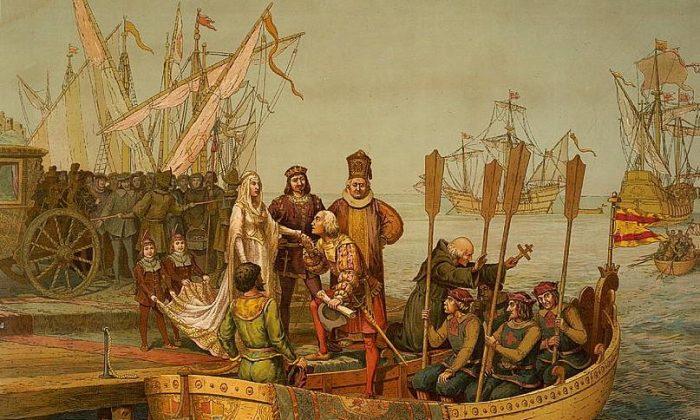There are a handful of holidays that are celebrated and studied with great fervor in schools across America—Columbus Day being one. Monday marks the 523rd anniversary of Columbus’s “discovery ”of the Americas. Surely, many school children will learn the familiar rhyme that has been passed down for centuries: “In 1492, Columbus sailed the ocean blue.”
At one time, it was truly believed that the Italian-born Christopher Columbus was the first person to discover the Americas. Many tales have been told of his epic voyage across the Atlantic in search of a Western trade route to Asia in service of the Spanish crown. Clearly, since his fateful landing in the Bahamas on Oct. 12, 1492, the world has never been the same, and his impact on Western civilization has proven undeniable.
Of course, the idea that Columbus was the first to discover the Americas has largely been debunked by historians, as evidence has since been discovered of explorations by the Vikings, Chinese, and others long before 1492.
What’s more, the fact that the “New World” was already inhabited by indigenous people and that Columbus’s followers were known to have enslaved and killed many native inhabitants, makes celebrating Columbus Day controversial, to say the least.
The modern-day holiday, which takes on varying significance for different groups of people, presents a unique opportunity for parents to explore history with their kids and encourage them to question and seek out for themselves the different ways history can be passed down and understood over time.
As Columbus Day approaches, here are a few ways to learn more about this important time in history alongside your kids.
Enjoy a Video Overview
When it comes to learning about and getting excited about history, a well-produced video can go a long way in illustrating the big-picture ideas and whetting one’s interest for further exploration. History.com has a number of helpful videos on Columbus.
Read
You will have no problem at all finding a trove of books for kids on the subject of Christopher Columbus. Hit the library and enjoy.
One standout worth mentioning is “Who Was First? Discovering the Americas,” by award-winning author Russell Freedman. It is a well-researched and easy-to-read book that delves into the different discoveries that have been made over time, shedding new light on the true history of America’s discovery.
Get Into the Act
Role-playing and recreating moments in history are creative and fun ways for kids to come to a deeper understanding of what they’re studying. Young kids will delight in crafting their own versions of Columbus’s famous fleet: the Niña, the Pinta, and the Santa Maria.
Older kids, perhaps, can recreate a map of Columbus’s four voyages to the New World. For more ideas than I could ever list here (you know what’s coming), get thee to Pinterest!
Find First-Hand Accounts
Real historians know that there are fewer more valuable resources than first-hand accounts when it comes to understanding the past. Christopher Columbus kept diligent, descriptive records of his voyages to the New World, a fact that made plausible the efforts of explorers who came after him.
The website americanjourneys.org has the complete journal of his first voyage available online.
There is nothing quite like reading a first-hand account of such a monumental moment in history, and that account can help one to decipher later accounts through a fresh lens. If your kids are old enough to attend to even a portion of these journals, open up this window to a different time for them.






